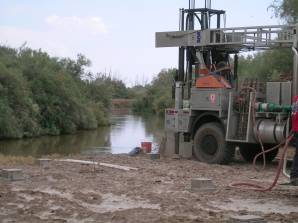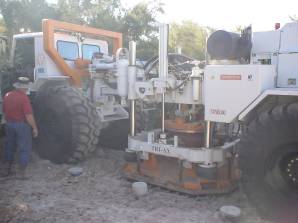 Site liquefaction during earthquake excitations is often associated with significant permanent displacement and lateral spreading that lead to costly damage to civil systems of all types. However, realtime field measurements of permanent displacements have eluded researcher and practitioners until recently, and hindered the development of reliable tools to predict site lateral spreading and failure. This project develops the capability to monitor the cyclic and permanent displacement of the WLA field site and use the associated measurements to characterize the in situ low and large strain dynamic properties for soil strata ranging from the ground surface to a depth of about 10 meters. A number of shape-acceleration arrays (SAA) have recently been installed permanently at the NEES@UCSB Wildlife liquefaction site to monitor low strain response as well as earthquake induced liquefaction, permanent deformation and lateral spreading. It is anticipated that an earthquake in the near future will induce large permanent deformation at this site. The installed arrays would then provide for the first time measurement of the time history of a site lateral spreading profile.
Site liquefaction during earthquake excitations is often associated with significant permanent displacement and lateral spreading that lead to costly damage to civil systems of all types. However, realtime field measurements of permanent displacements have eluded researcher and practitioners until recently, and hindered the development of reliable tools to predict site lateral spreading and failure. This project develops the capability to monitor the cyclic and permanent displacement of the WLA field site and use the associated measurements to characterize the in situ low and large strain dynamic properties for soil strata ranging from the ground surface to a depth of about 10 meters. A number of shape-acceleration arrays (SAA) have recently been installed permanently at the NEES@UCSB Wildlife liquefaction site to monitor low strain response as well as earthquake induced liquefaction, permanent deformation and lateral spreading. It is anticipated that an earthquake in the near future will induce large permanent deformation at this site. The installed arrays would then provide for the first time measurement of the time history of a site lateral spreading profile.
 Specifically, this project comprises the following tasks: (1) development and validation of optimal array configurations using centrifuge model tests and computational analysis, (2) installation of a number of shape-acceleration arrays within an optimal configuration at the NEES@UCSB Wildlife liquefaction site, (3) excitation of the site using the NEES@Texas T-Rex vibrator, and (4) development of innovative data reduction and identification tools to estimate the 3-dimensional (small and large strain) dynamic properties and response mechanisms of the Wildlife site as well as other field sites that may be instrumented in the future. This project will have a broad impact on our capabilities to test in situ soil systems, evaluate their (low and large strain) mechanical properties and calibrate computational models of these systems, all while avoiding the issues of soil sample disturbance and limitation of small scale or sample testing. The outcome of the planned research will contribute to the development of more robust modeling procedures and predictive tools of soil systems to reduce losses associated with earthquakes.
Specifically, this project comprises the following tasks: (1) development and validation of optimal array configurations using centrifuge model tests and computational analysis, (2) installation of a number of shape-acceleration arrays within an optimal configuration at the NEES@UCSB Wildlife liquefaction site, (3) excitation of the site using the NEES@Texas T-Rex vibrator, and (4) development of innovative data reduction and identification tools to estimate the 3-dimensional (small and large strain) dynamic properties and response mechanisms of the Wildlife site as well as other field sites that may be instrumented in the future. This project will have a broad impact on our capabilities to test in situ soil systems, evaluate their (low and large strain) mechanical properties and calibrate computational models of these systems, all while avoiding the issues of soil sample disturbance and limitation of small scale or sample testing. The outcome of the planned research will contribute to the development of more robust modeling procedures and predictive tools of soil systems to reduce losses associated with earthquakes.



